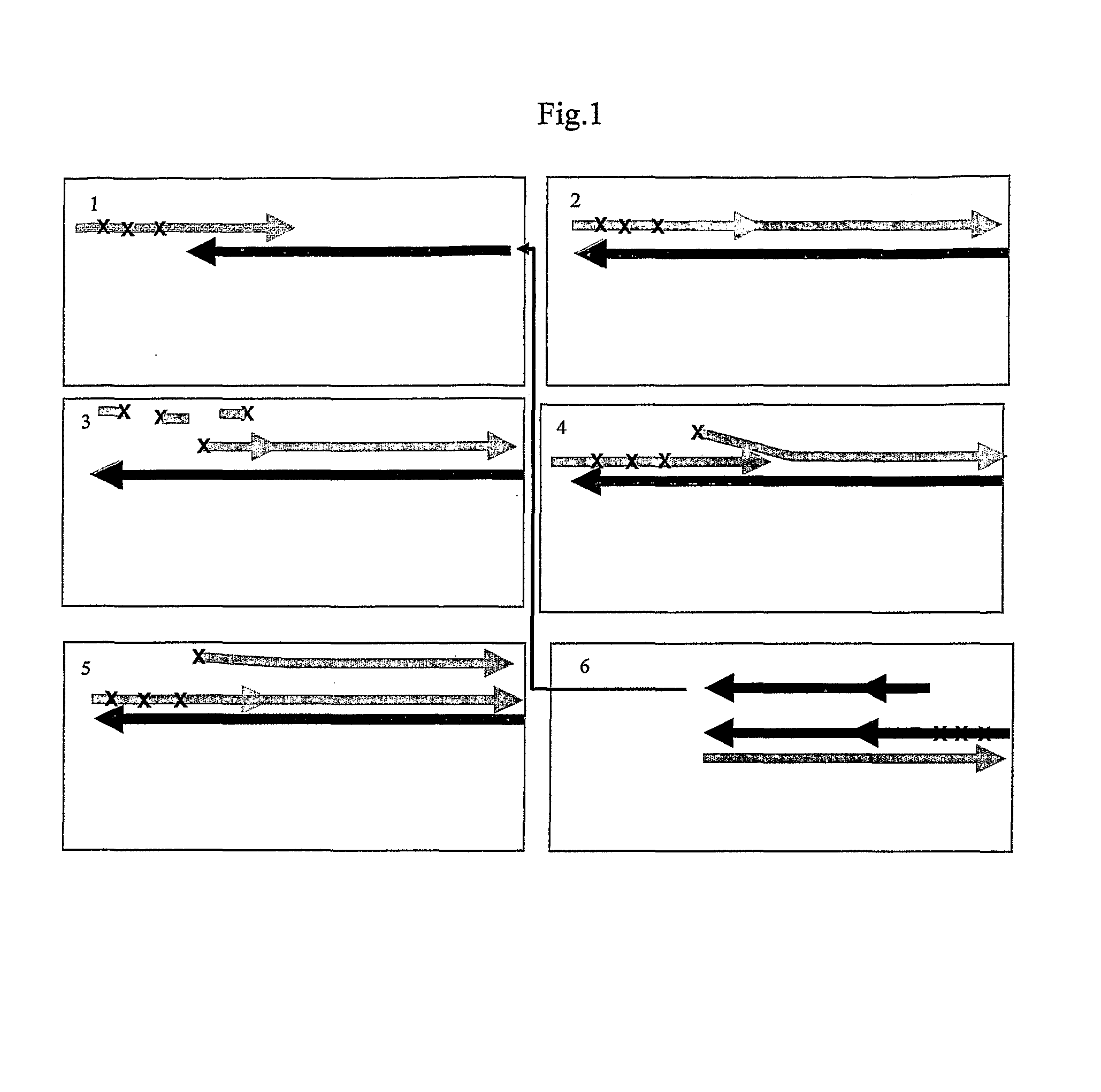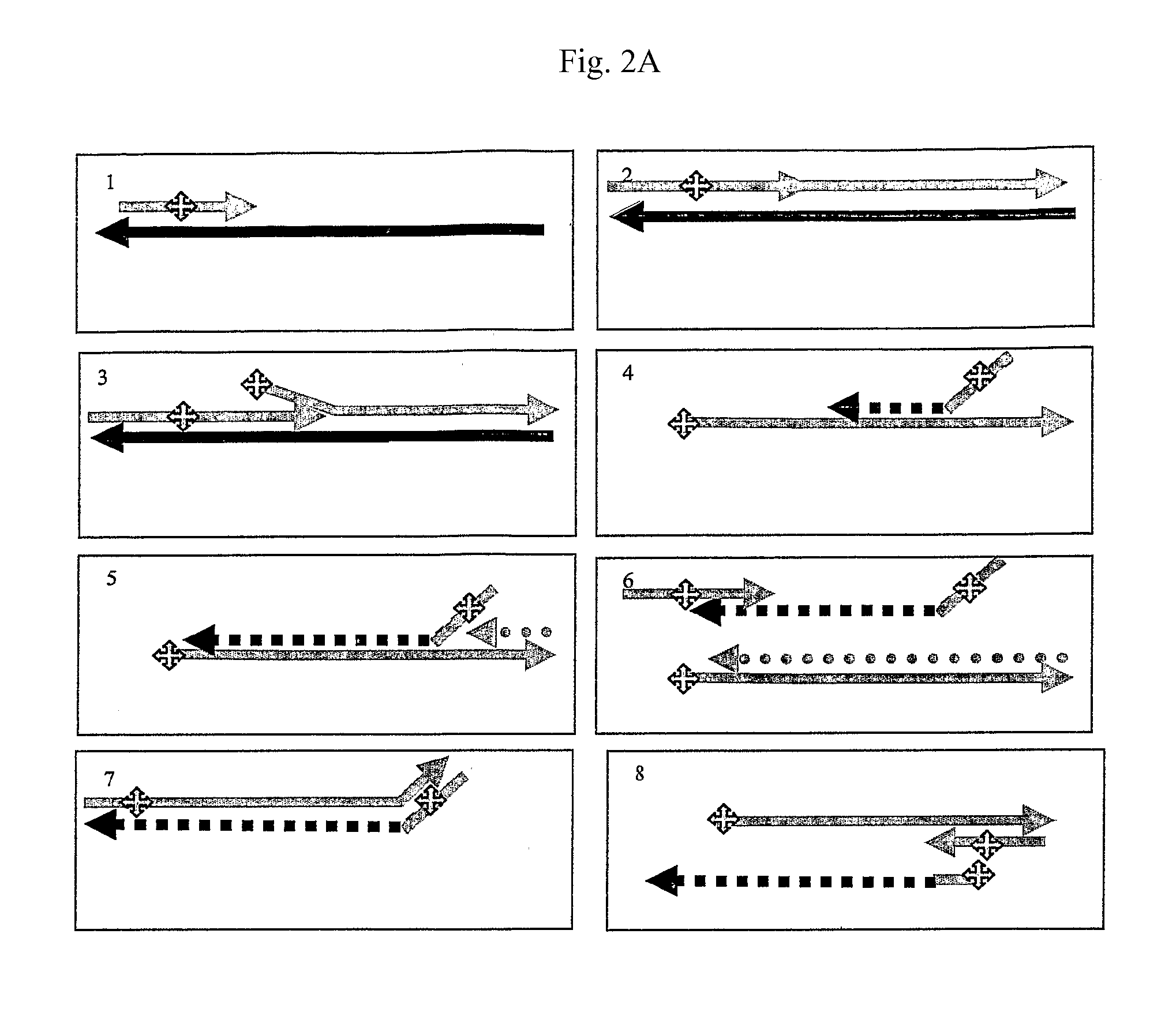Isothermal amplification of nucleic acids
a nucleic acid and isothermal technology, applied in the field of isothermal amplification of nucleic acids, can solve the problems of difficult to distinguish specific attachment of a probe to its target sequence, and cannot directly apply to cases
- Summary
- Abstract
- Description
- Claims
- Application Information
AI Technical Summary
Benefits of technology
Problems solved by technology
Method used
Image
Examples
example 1
See FIG. 5
Exonuclease Dependent Isothermal Amplification Using a Fluorescent Detector Probe
[0221]All reagents used were molecular biology grade and obtained from Sigma-Aldrich. T7 gene 6 exonuclease (50 U / μl) was purchased from GE Healthcare, Klenow Fragment 3′-5′ exo− (10 U / μl) and high purity standard deoxynucleoside triphosphates (dNTPs) were purchased from Jena Bioscience, Loebstedter Str 78, Jena, Germany. Oligonucleotide primers and synthetic template were purchased from Thermo Electron and were HPLC purified. PCR-ready Human hepatic cDNA (0.5 ng / μl) was purchased from Ambion Inc, Austin Tex., Human genomic DNA (buffy coat) (200 ng / μl) was purchased from Roche and Lambda phage DNA (500 ng / μl) was purchased from NEB. Sybr Green I was purchased from Invitrogen.
[0222]The sequence of oligonucleotide primers, detector probe and template sequences used in this example are given in table 1.
[0223]
TABLE 1PTO-P25′ CTCAACGACCA*C*T*T*TGTCAAG[SEQ. ID NO: 1]PTO-P15′ TAGCCAAATTC*G*T*T*GTCATA...
example 2
See FIG. 6
Glycosylase Dependent Isothermal Amplification.
[0228]All reagents used were molecular biology grade and except where stated, were obtained from Sigma-Aldrich. Human 8-oxoguanine DNA glycosylase a isoform (hOGG1) (1.6 U / μl) was purchased from NEB, Klenow Fragment 3′-5′ exo− (10 U / μl) Jena Bioscience, Loebstedter Str 78, Jena, Germany. Oligonucleotide primers and synthetic template were purchased from Thermo Electron and were HPLC purified. Sybr Green I was purchased from Invitrogen.
[0229]The sequence of oligonucleotide primers, detector probe and template sequences used in this example are given in table 2.
[0230]
TABLE 2OX-P15′ AGCATAGoCAAACoGATAAGTGGTCTAC[SEQ. ID NO: 6]OX-P25′ CTTGAoTGCGTCAoTTGCTATGATCCAG[SEQ. ID NO: 7]Synthetic oligonucleotide template5′ CTTGAGTGCGTCAGTTGCTATGATCCAGCTGTAGACCACTTATC[SEQ. ID NO: 8](ST1)CGTTTGCCTATGCT‘o’, 8-oxoguanmne
Assay Components
[0231]All concentrations are the final concentrations in a reaction volume of 50 μl.
[0232]Amplification primers...
example 3
RNase Dependent Isothermal Amplification Using a Fluorescent Detector Probe
[0235]All reagents are molecular biology grade and can be obtained from Sigma-Aldrich. E. coli RNase H (10 U / μl) can be purchased from Epicentre, Madison, Wis., Superscript II reverse transcriptase (200 U / μl) can be purchased from Invitrogen, RNase inhibitor (40 U / μl) can be purchased from Ambion Inc, Austin Tex., Klenow Fragment 3′-5′ exo− (10 U / μl) and high purity standard deoxynucleoside triphosphates (dNTPs) can be purchased from Jena Bioscience, Loebstedter Str 78, Jena, Germany. Oligonucleotide primers and synthetic template can be purchased from Thermo Electron and were HPLC purified. Sybr Green I is purchased from Invitrogen.
[0236]The sequence of oligonucleotide primers, detector probe and template sequences that can be used in this example are given in table 3.
[0237]
TABLE 3RD-P25′ ctcaacgaccACTTTGTCAAG[SEQ. ID NO: 9]RD-P15′ tagccaaattCGTTGTCATA[SEQ. ID NO: 10]Synthetic oligonucleotide template5′ CAAC...
PUM
| Property | Measurement | Unit |
|---|---|---|
| temperature | aaaaa | aaaaa |
| temperature | aaaaa | aaaaa |
| ionic strength | aaaaa | aaaaa |
Abstract
Description
Claims
Application Information
 Login to View More
Login to View More - R&D
- Intellectual Property
- Life Sciences
- Materials
- Tech Scout
- Unparalleled Data Quality
- Higher Quality Content
- 60% Fewer Hallucinations
Browse by: Latest US Patents, China's latest patents, Technical Efficacy Thesaurus, Application Domain, Technology Topic, Popular Technical Reports.
© 2025 PatSnap. All rights reserved.Legal|Privacy policy|Modern Slavery Act Transparency Statement|Sitemap|About US| Contact US: help@patsnap.com



